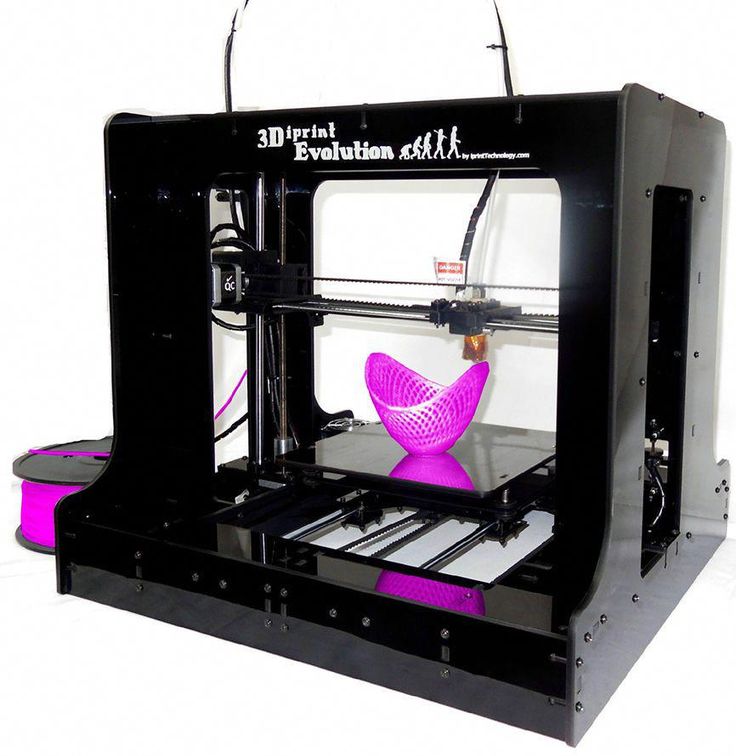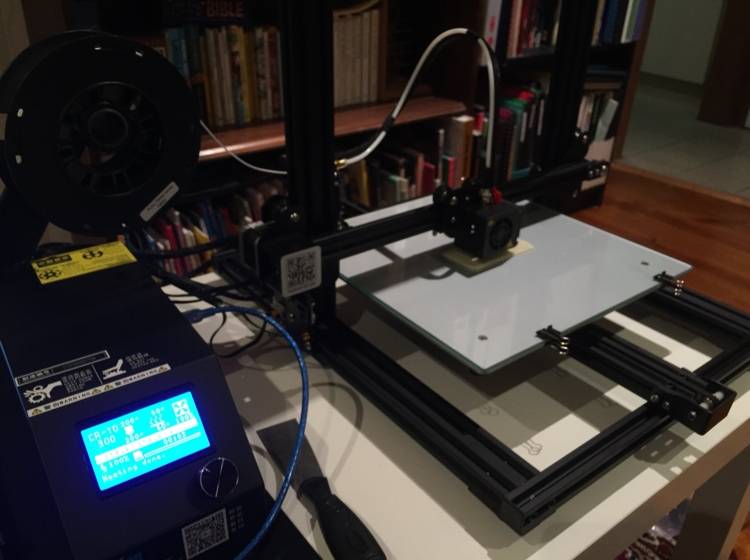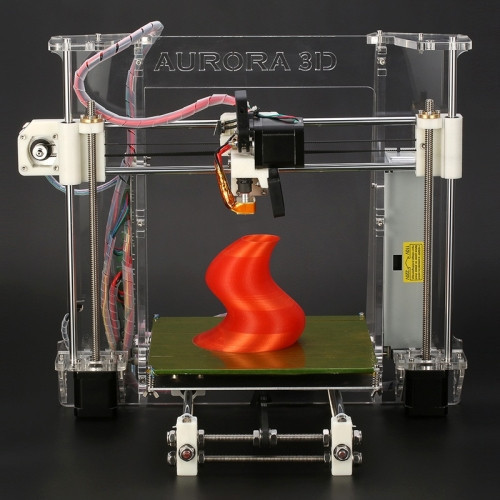Is it legal to 3d print guns
3D Printed Guns: What is The Law?
Skip to contentLiberator 3D Printed Gun
3D printed guns are a hot-button issue. The Liberator took center stage in 2013 when blueprints were released for this 3D-printed, fully-operational single-shot pistol. The inventor of the Liberator, Cody Wilson, started a company called Defense Distributed for the purpose of sharing his invention with the world. Thousands downloaded the blueprints, allowing them to print a plastic gun on a compatible 3D printer.
The federal government quickly took down the blueprints, stating that providing blueprints online was illegal trafficking of firearms. Additionally, the federal government argued that the Liberator, being that it is printed entirely from plastic, isn’t detectable by standard metal detectors, making it illegal under federal law.
Cody Wilson responded by filing a lawsuit for the violation of his First Amendment right to free speech. He argued that the source code is a form of speech and he has a right to share it with the world. Government censorship would be unconstitutional; and so, this case was settled prior to reaching the Supreme Court. Without guidance from the highest court, we may see some legal battles on the horizon.
Enjoying this content? Find out how you can get more sent straight to your inbox.
Are 3D Printed Guns Legal to Build?
Yes. Americans have always been able to manufacture their own firearms and 3D-printed guns aren’t any different. Just like machining parts to build your own AR-15, you can use the blueprints of the Liberator to print your own polymer pistol.
3D Printing Gun Law
While federal law freely allows individuals to make firearms, for their personal use, in light of the 3D-printed gun technology, some states that embrace anti-gun laws are beginning to discuss legislation that will prevent people from building their own guns.
For example, New Jersey has drafted and passed a ban on homemade firearms that is not yet law, and California, while not prohibiting them outright, requires them to be serialized and registered. So be sure to get in touch with your state’s U.S. LawShield Independent Program Attorney for the current status of your state’s law.
It is important to keep in mind that these items are still firearms. Even though you can print one in the comfort of your own home, if you are disqualified from possessing a firearm you cannot possess a 3D-printed gun either.
You cannot sell these firearms as part of a commercial business without first becoming a licensed manufacturer. There is no bright line here. If you decide to manufacture 80 guns for private sale you might start to look like an unlicensed firearm dealer and you’ll find yourself subject to some unwanted legal scrutiny.
There’s a lot of controversy surrounding 3D-printed guns and you will likely see headlines in the near future addressing some of the remaining legal issues.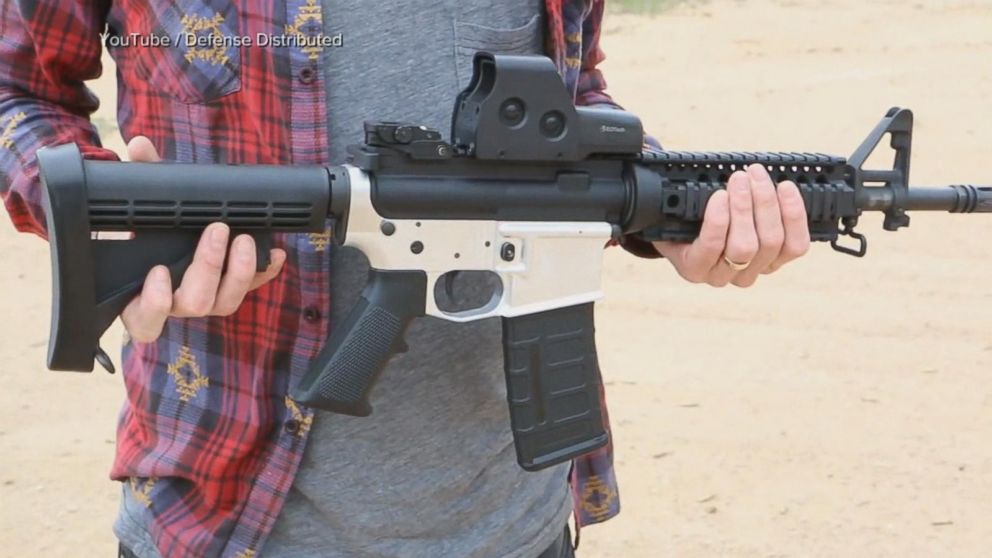 In the meantime, U.S. & Texas LawShield will always keep you informed with the latest in gun laws, safety, and stories from our members across the nation.
In the meantime, U.S. & Texas LawShield will always keep you informed with the latest in gun laws, safety, and stories from our members across the nation.
BECOME A MEMBER
Your Protection Starts Here!
Become a part of the nation’s best Legal Defense for Self Defense® Program and get armed, educated, and prepared today.
BECOME A MEMBER
- All CategoriesBuild your skillsConcealed CarryConstitutional CarryDiscussionFeaturedGear ReviewGuarding the FamilyGun Owners’ RightsGun Safety & EducationHistoryHuntingLawLegislationMember’s VoiceNew Gun OwnersNewsNonvideoPepper SprayPets & AnimalsPoliticsPressSecond AmendmentSelf-DefenseTexas LawShieldTravelU.S. LawShieldVideosWhat To Do In An Emergency
Go to Top
What Are 3D-Printed Guns, and Are They Legal?
For decades, weapons manufacturing has been the domain of arms industry heavyweights: Glock, Sig Sauer, Remington, Sturm, Ruger & Co. Making a gun from scratch at home required thousands of dollars of machining equipment and years of engineering expertise.
Making a gun from scratch at home required thousands of dollars of machining equipment and years of engineering expertise.
But in recent years, that has begun to change. Advancements in 3D-printing technology have yielded increasingly reliable 3D-printed firearms, many of which require no federally regulated components to function. Below, we break down the basics of plastic, 3D-printed firearms, and the controversy generated by the swelling movement to deliver them to the masses.
What is a 3D-printed gun?In the simplest terms, it’s any firearm that includes components manufactured with a 3D printer.
But 3D-printed guns vary a lot. Some models — like the 3D-printed gun company Defense Distributed’s “Liberator” — can be made almost entirely on a 3D printer. Others require many additional parts, which are often metal. For example, many 3D-printed gun blueprints focus on a weapon’s lower receiver, which is basically the chassis of a firearm. Under federal law, it’s the only gun part that requires a federal background check to purchase from a licensed dealer. To subvert regulators, some people print lower receivers at home and finish their guns using parts that can be purchased without a background check — metal barrels, for example, or factory buttstocks. Many gun retailers sell kits, which include all the components necessary to assemble a gun at home.
To subvert regulators, some people print lower receivers at home and finish their guns using parts that can be purchased without a background check — metal barrels, for example, or factory buttstocks. Many gun retailers sell kits, which include all the components necessary to assemble a gun at home.
Advances in printing technology have driven the price of 3D printers down — they’re now around $200 on Amazon — and gun groups offer guides for getting started. These developments have lowered the barriers to entry for those in search of untraceable guns, which have turned up at crime scenes with increasing frequency over the past few years.
The process still remains more involved than most methods of obtaining a firearm, though. For instance, 3D printers require meticulous setup — the component that extrudes plastic must be calibrated, software must be downloaded to convert designs into 3D-printable slices, and the printer must undergo a slew of upgrades to reliably print weapons parts, which themselves require precise construction to ensure they can contain the explosion from a gunshot.
Because 3D-printed guns are made outside traditional supply chains, and don’t require background checks, they’re effectively invisible to law enforcement agencies. They are a form of ghost gun: unserialized, and unable to be traced if recovered by law enforcement.
There isn’t good data on the number of 3D-printed firearms that have turned up at crime scenes, though state attorneys general opposed to the technology insist that some have been recovered. On a few occasions, crimes involving the guns have made headlines. In February 2019, police arrested a Texas man after he was found test-firing a 3D-printed gun in the woods. He was prohibited from purchasing firearms and had a hit list of lawmakers on him.
Of particular concern to many law enforcement agencies are guns that can be completely 3D-printed at home without metal components. Politicians and law enforcement professionals fear that such guns would be able to evade metal detectors, and thus slip into places where firearms are prohibited, like airports or government buildings. At present, these fears are largely unfounded — 3D-printed gun designers have yet to develop an alternative to metal bullets, and security officials say that X-ray detection in place alongside most metal detectors can identify the outline of 3D-printed firearms with ease. Indeed, Transportation Security Administration officers have seized 3D-printed firearms at airports on several occasions.
At present, these fears are largely unfounded — 3D-printed gun designers have yet to develop an alternative to metal bullets, and security officials say that X-ray detection in place alongside most metal detectors can identify the outline of 3D-printed firearms with ease. Indeed, Transportation Security Administration officers have seized 3D-printed firearms at airports on several occasions.
Still, the weapons’ lack of traceability has already caught the attention of terror groups, according to Mary McCord, a former U.S. attorney and prosecutor in the Department of Justice’s National Security Division. “We know from a counterterrorism perspective that there’s great interest among terrorist organizations in being able to have workable, usable, efficient, functioning 3D-printed weapons.”
Is it legal to make a gun using a 3D printer?In most cases, yes. Federal law permits the unlicensed manufacture of firearms, including those made using a 3D printer, as long as they include metal components.
In the absence of federal regulation, a handful of states have taken their own steps to clamp down on the creation of homemade guns. In California, anybody manufacturing a firearm is legally required to obtain a serial number for the gun from the state, regardless of how it’s made. In New Jersey, you are supposed to obtain a federal manufacturing license before 3D-printing a gun. The state also criminalizes the manufacture, sale, or possession of undetectable firearms, and made it illegal to purchase parts to make an unserialized gun. Several states — including New Mexico and Virginia — are considering bills that would enact similar restrictions.
What about sharing the blueprints online?The legality of sharing the files required to print guns and gun components is murkier territory. No federal legislation bans the practice. But in 2013, the State Department ruled that releasing blueprints online violated arms export laws. In 2018, after a lengthy court battle with Defense Distributed over the guidance, the State Department settled, and agreed to permit the files’ release.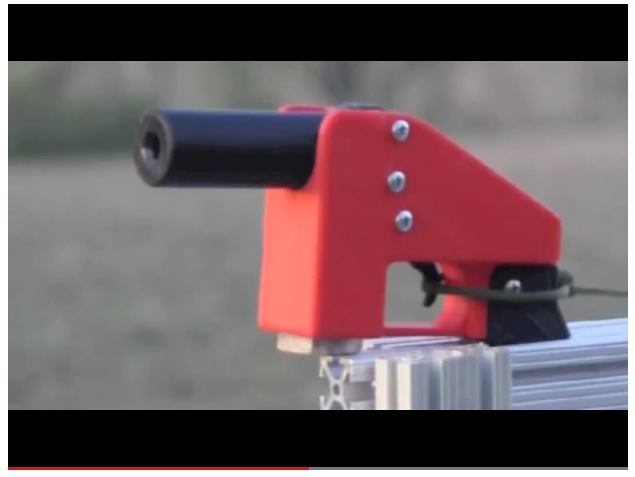 But before the prohibition was lifted, a coalition of states sued to keep it in place — and won. Now, gun groups intent on sharing the files online have exploited a loophole in the State Department’s policy, which allows for the distribution of blueprints exclusively to U.S. residents. Defense Distributed maintains it has established a vetting procedure to ensure only U.S. residents are able to download them.
But before the prohibition was lifted, a coalition of states sued to keep it in place — and won. Now, gun groups intent on sharing the files online have exploited a loophole in the State Department’s policy, which allows for the distribution of blueprints exclusively to U.S. residents. Defense Distributed maintains it has established a vetting procedure to ensure only U.S. residents are able to download them.
In 2019, the Trump administration transferred oversight of gun exports from the State Department to the Commerce Department, which would have rolled back restrictions on releasing 3D-printed gun blueprints. But a second suit filed by the coalition of state attorneys general has kept oversight of the files with the State Department, pending future litigation.
New Jersey Attorney General Gurbir Grewal is a plaintiff in the case. “If a company like Defense Distributed can simply sell printable [gun blueprints] to their customers without running the usual required background checks to make sure someone’s not a criminal, it would blow up the entire regime of firearm laws that we have in this country,” he said.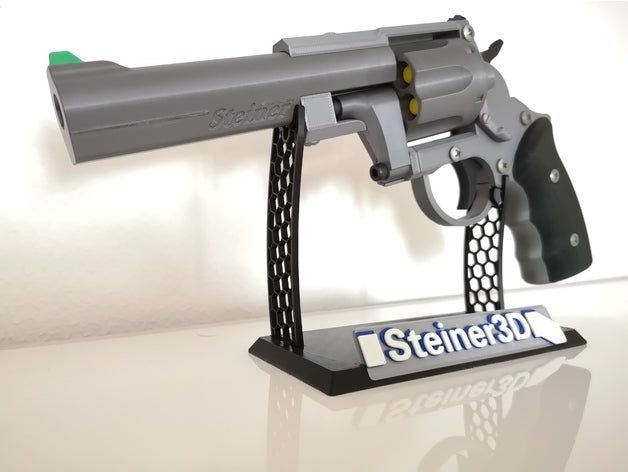
In 2019, after Grewal sought an injunction to block Defense Distributed from releasing files to New Jersey residents, the company countersued. It alleges that the blueprint files are a form of speech, and that Grewal’s effort to block their release violates the First Amendment. The case has yet to go to trial.
Who is printing guns — and why?The first 3D-printed firearm to make a splash in the popular consciousness was the “Liberator” — a near fully plastic gun designed by a self-described anarchist and ghost-gun advocate named Cody Wilson. (Designs for the Liberator call for a small steel block to be sealed inside the plastic in order to comply with federal law.) Wilson founded Defense Distributed to advance and share the technology, and has initiated many of the group’s highest profile legal battles. In 2019, Wilson was sentenced to probation and ordered to register as a sex offender after soliciting sex from a minor.
Though Wilson’s is the best-known and formally recognized gun printing “company,” the practice is mostly advanced by informal collectives across the internet. These groups, like Deterrence Dispensed and Fosscad, gather anonymously in chat rooms and on social media platforms to crowdsource the development of new gun designs and spread them across the web. They have thousands of members, but remain mostly decentralized, making it difficult for technology companies or law enforcement agencies to police them.
These groups, like Deterrence Dispensed and Fosscad, gather anonymously in chat rooms and on social media platforms to crowdsource the development of new gun designs and spread them across the web. They have thousands of members, but remain mostly decentralized, making it difficult for technology companies or law enforcement agencies to police them.
Over the past two years, however, the groups have run up against censorship policies at major tech platforms, many of which prohibit weapons content. As a result, they’ve been forced to increasingly obscure corners of the internet. Most recently, the operations hub for most of the 3D-printed gun groups — an encrypted chat and file-sharing platform called Keybase — pledged to remove all weapons-related content, and told the groups they would be banned.
Proponents of the technology fall into several different camps. Some, like Mustafa Kamil, a creator of 3D-printable guns based in Romania, and a member of the Deterrence Dispensed team on Keybase, think that concerns over homemade weapons are overblown. Gun printing, he says, is mostly the domain of hobbyists like himself: technical experts interested in tinkering and engineering. To 3D-print a gun: “you need to have enough money to buy a printer. Then you need enough expertise and experience to know how to use the printer. If your axis is off by 0.15 millimeters the gun isn’t going to work,” he said. “To buy a black market firearm would be much easier.” Kamil said he’s owned 32 printers and completed two apprenticeships with gun manufacturers.
Gun printing, he says, is mostly the domain of hobbyists like himself: technical experts interested in tinkering and engineering. To 3D-print a gun: “you need to have enough money to buy a printer. Then you need enough expertise and experience to know how to use the printer. If your axis is off by 0.15 millimeters the gun isn’t going to work,” he said. “To buy a black market firearm would be much easier.” Kamil said he’s owned 32 printers and completed two apprenticeships with gun manufacturers.
Others see the potential for armed conflict with the government as the driving force behind their creations. Members of Deterrence Dispensed and Defense Distributed have fashioned a brand out of this perceived threat, adopting popular Second Amendment slogans like “Come and Take It,” “Live Free or Die,” and “Free Men Don’t Ask.” Leaders of the groups share a deep conviction that gun ownership is the only way to ensure freedom: In an interview with Popular Front, a conflict journalism outfit, the founder of Deterrence Dispensed — a man who goes by the username jstark — continuously pointed to the threat of government tyranny as a justification for creating 3D-printed guns and distributing their blueprints.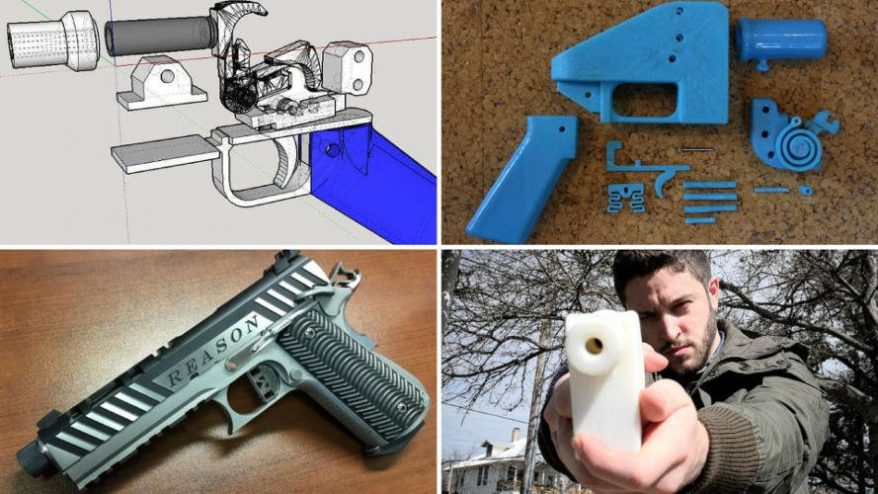 “Just look at the Uighurs in China,” he said, referring to the ongoing genocide of the ethnic minority. “Just look what’s happening to them. No one’s helping them. Nobody does shit. You know what would help them? If they were armed. That would be a deterrence.”
“Just look at the Uighurs in China,” he said, referring to the ongoing genocide of the ethnic minority. “Just look what’s happening to them. No one’s helping them. Nobody does shit. You know what would help them? If they were armed. That would be a deterrence.”
To jstark, identical threats exist anywhere where civilians are largely unarmed, including in Europe, where he lives. When asked if he would fight police who tried to confiscate his guns, he was frank: “Basically, yes. Live free, or die. These are not empty words.”
Are these groups aligned with extremists?While politicians and law enforcement agencies have dubbed the advocates of 3D-printed firearms extremists, the movement has no unifying political ideology. Jstark, for his part, said in the Popular Front interview that Deterrence Dispensed has no tolerance for people who wish to harm others: “If they do show through [their actions] that they’re extremists, racists, islamic terrorists — then we would kick them out immediately,” he said. He did not respond to multiple requests for comment.
He did not respond to multiple requests for comment.
The alarmism about about looming government tyranny has attracted groups eager to ignite government conflict, particularly in the U.S. Members of groups connected to the boogaloo, a loose-knit coalition of anti-government extremists that advocates a violent civil war, have seen 3D-printed gun advocates as allies in an overlapping struggle. Last summer, Megan Squire, a professor at Elon University, tracked online boogaloo-connected groups as they navigated crackdowns from social media platforms. Many ended up on Keybase, drawn by the large and growing 3D-printed gun community.
In early April, Deterrence Dispensed released blueprints for a printable auto sear — a component that can be used to turn a semiautomatic rifle into an illegal, fully automatic firearm — called the “Yankee Boogle,” an apparent boogaloo reference. In September, two boogaloo adherents were charged for allegedly attempting to sell auto sears to representatives of Hamas, the Islamist extremist group. In court documents, prosecutors alleged that one of the defendants in that case said he obtained the auto sears from a supplier who 3D-printed them. In a separate case, federal prosecutors charged a man from West Virginia with 3D-printing auto sears and selling more than 600 of them online, including to several boogaloo adherents. One man who bought the 3D-printed auto sears is accused of killing a police officer and a security guard in California. It is unclear if any of the auto sears used in these crimes were designed by Deterrence Dispensed.
In court documents, prosecutors alleged that one of the defendants in that case said he obtained the auto sears from a supplier who 3D-printed them. In a separate case, federal prosecutors charged a man from West Virginia with 3D-printing auto sears and selling more than 600 of them online, including to several boogaloo adherents. One man who bought the 3D-printed auto sears is accused of killing a police officer and a security guard in California. It is unclear if any of the auto sears used in these crimes were designed by Deterrence Dispensed.
Correction: An earlier version of this article highlighted a case in which police in Rhode Island said a suspect used a 3D-printed gun in a murder. While police initially made that claim, an analysis by the state crime lab later ruled the method of manufacture “undetermined.” The story has also been updated to include that Defense Distributed’s “Liberator” gun model includes a small metal component for federal compliance.
is it possible to print pneumatic and firearms
Is it possible to make a gun on a 3D printer and is it legal?
Today's 3D printers offer enormous possibilities. They can print products of almost any complexity. Until quite recently, it was difficult to even imagine that a plastic weapon could shoot. However, it is already possible to make a pistol on a 3D printer, which, although not reliable, still fires live ammunition.
Can firearms be 3D printed?
Back in 2013, a young American gun fighter proved that plastic guns could be 3D printed. He was the first in the world to make a pistol in this way, in which only the striker was made separately from metal. All other parts were printed on an FDM printer.
Today's 3D printers are capable of printing any CAD model, and these models of firearms have been available for over 10 years. If in previous years their printing required professional skills, now almost any user can master them. With a 3D printer and a finished model, it became quite possible to print a gun. Another thing is that such "creativity" is punishable by the laws of most countries.
With a 3D printer and a finished model, it became quite possible to print a gun. Another thing is that such "creativity" is punishable by the laws of most countries.
The evolution of 3D printed weapons
Despite all the prohibitions and restrictions, the evolution of 3D printed firearms is moving at a great speed. The beginning was laid by the single-shot plastic pistol Liberator by American K. Wilson, which appeared in 2013. It had a simple design and was chambered for 380 ACP. Already after 10-12 shots, this weapon became unusable. However, the very possibility of printing firearms served as an impetus for the development of the idea. The author of the first pistol himself founded the Defense Distributed company, which began to actively improve the technology.
One of the ways to increase the durability of weapons was to increase the number of their barrels. At the beginning of 2014, the Japanese Y. Imura makes a 38 caliber Zig Zag pistol. He was able to fire up to 6 shots non-stop. The author of the weapon was recognized as a criminal and convicted.
The author of the weapon was recognized as a criminal and convicted.
The next step was the production of a six-shot revolver by J. Patrick in 2015. The PM522 Washbear has been shown in action on YouTube. The weapon was noticeably safer for the shooter compared to previous versions, but still allowed to fire only a few dozen rounds.
The first semi-automatic pistol for a 9 mm bullet appeared in 2016 under the name Shuty-MP1. It was developed by a handicraft gunsmith who hid under the pseudonym Derwood. It wasn't exactly a plastic weapon. The author used some metal parts from factory pistols - a barrel, a firing pin, a bolt and several springs. This made it possible to ensure a rate of fire of more than 46 rounds / min. However, when changing the store, the plastic case had to be cooled. In 2017, the same master proposed an improved model - Shuty AP-9.
The main contribution to the development of 3D printed weapons technology was made by Defense Distributed, which united a group of like-minded activists. First, these enthusiasts won legal proceedings in the United States and obtained permission to 3D-print weapons, which greatly expanded their capabilities. Secondly, they were able to set up a professional business with product testing and quality control. As a result, in 2018–19 they developed numerous models of a variety of firearms - from pistols to carbines. They posted over 30 files for printing original gun parts. Most of them were plastic, and the metal parts were not made from purchased, ready-made elements, but from simple metal profiles (tubes, strips, etc.), which are sold in ordinary hardware stores. This made it possible to exclude the use of parts patented by gunsmiths.
First, these enthusiasts won legal proceedings in the United States and obtained permission to 3D-print weapons, which greatly expanded their capabilities. Secondly, they were able to set up a professional business with product testing and quality control. As a result, in 2018–19 they developed numerous models of a variety of firearms - from pistols to carbines. They posted over 30 files for printing original gun parts. Most of them were plastic, and the metal parts were not made from purchased, ready-made elements, but from simple metal profiles (tubes, strips, etc.), which are sold in ordinary hardware stores. This made it possible to exclude the use of parts patented by gunsmiths.
At the moment, the semi-automatic carbine FGC-9, developed on the basis of the Shuty AP-9, has become the pinnacle of "creativity" of Defense Distributed. At the same time, there is not a single factory part in it. The barrel for the 9 mm cartridge is made of steel pipe using electrochemical processing.
Where can I get drawings and what should I look for?
Gun manufacturing bans make it much harder to get blueprints and models of guns for 3D printing. The right to free placement of information was achieved only by Defense Distributed. Their website provides free access to drawings, models and technologies. Other information can be found on the Internet, but they are usually illegal.
When choosing a model, pay attention to the following information:
- material used;
- cartridge for which the model is designed;
- number of cartridges in the magazine, rate of fire;
- operating time before failure.
It is important to clarify which metal parts will need to be purchased separately, in addition to plastic for printing on a printer.
What does the law say in different countries?
The only country where firearms can be 3D printed is the United States. Gun Control Act 19 applies here68, giving Americans the right to make weapons, but only for personal use. Only one limitation is put forward: it must be determined by metal detectors, that is, it must have a metal element. In virtually all other countries, homemade manufacture and repair of weapons for any purpose is prohibited by law. In Russia, printing it on a 3D printer falls under the Criminal Code of the Russian Federation and is punishable by imprisonment.
Only one limitation is put forward: it must be determined by metal detectors, that is, it must have a metal element. In virtually all other countries, homemade manufacture and repair of weapons for any purpose is prohibited by law. In Russia, printing it on a 3D printer falls under the Criminal Code of the Russian Federation and is punishable by imprisonment.
Should we be afraid of plastic weapons?
The question of how dangerous a weapon printed on a printer is becoming increasingly important. Despite all the prohibitions, it is extremely difficult to control the spread of technology around the world. The availability of 3D printers and the increase in their functionality make it possible to master the production of plastic guns at home. How dangerous is such a weapon?
Most experts agree that currently printed weapons are more of an interesting toy. It is quite expensive and is designed to carry out only a few dozen shots. Moreover, such pistols are quite dangerous for the shooter himself with live ammunition, because they can explode in their hands.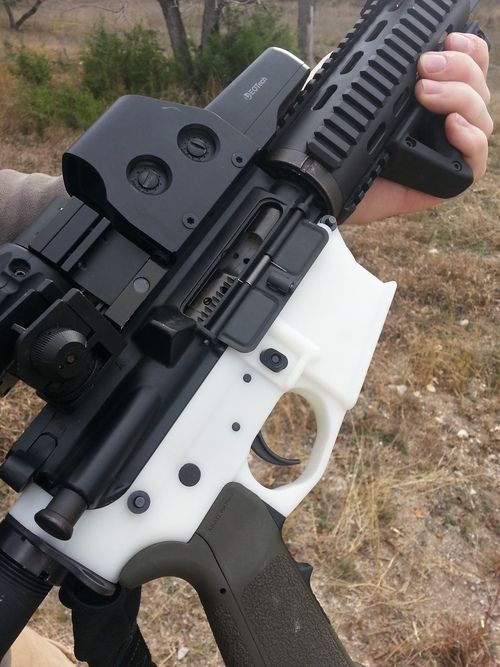
However, the danger cannot be underestimated. It is easier and cheaper for a "serious" criminal to buy illegal military weapons than to make them on a printer. At the same time, there may be "enthusiasts" who, for their own interest, can make a pistol and try it out in action. Such inadequate people represent an undoubted danger. In addition, the temptation is great for terrorists. Metal detectors do not detect a plastic gun, which means that it is easier to carry it, for example, on an airplane.
Important! Plastic weapons have a very small resource. At the same time, sometimes just one shot is enough to kill a person.
3D printed firearms have the following advantages:
- the ability to make military weapons at home;
- light weight;
- availability of materials;
- Ability to copy famous weapon models.
Always remember that there are significant disadvantages:
- illegal production;
- high cost of weapons;
- very small resource and limited rate of fire;
- danger to the shooter himself.
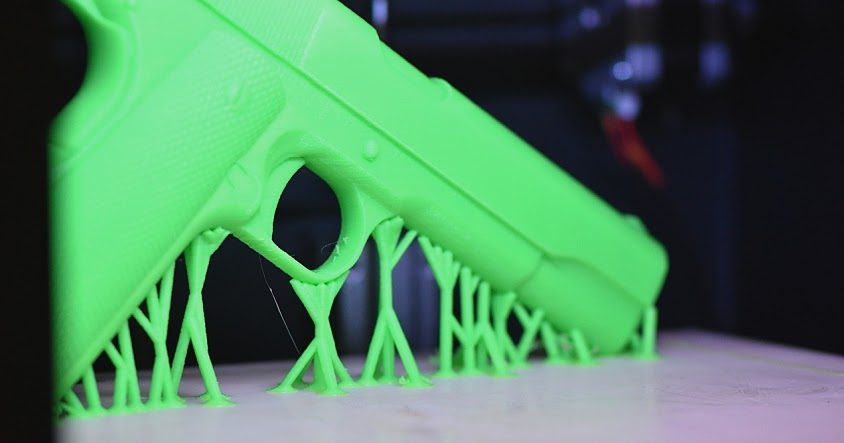
Currently, plastic weapons have more disadvantages than advantages, and most importantly, you can get a real prison term for making them.
Prospects for printing weapons
The potential for 3D printing of firearms is far from exhausted. The expansion of equipment capabilities and the development of innovative materials indicate that in the near future such weapons may approach military weapons in terms of characteristics. In the future - a significant increase in the resource and the provision of automatic firing.
Significantly increases the reliability of printed pistols and carbines SLS technology using metal powder. Such weapons already differ little from the factory metal models. While it is very expensive, which significantly limits the application. However, over time, the material will become cheaper, which means it will become more affordable.
Printing firearms on a 3D printer has become a reality. Despite its extremely low performance and reliability, interest is growing in it.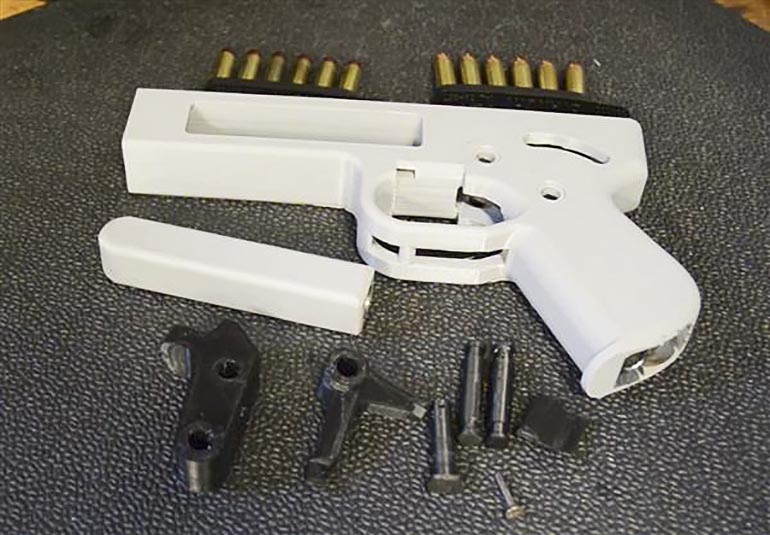 Experts predict that the printing of weapons will become widespread, and it is impossible to stop such production. There comes a time when measures should be taken at the legislative level to establish effective control over this process.
Experts predict that the printing of weapons will become widespread, and it is impossible to stop such production. There comes a time when measures should be taken at the legislative level to establish effective control over this process.
- March 21, 2021
- 4046
Get expert advice
3D printed weapons: myth or reality?
Photo: Scott Olson / Getty Images
Is it possible to create a pistol, submarine or grenade launcher using 3D printing and without legal consequences, found out the host of the RBC Trends YouTube channel Nikolai Dubinin
logos on a 3D printer is gradually entering the industrial circulation. Many are wondering what the potential of this technology is. In September 2020, an underground workshop was found in Spain with two 3D printers, an exact copy of an assault rifle, and parts of other weapons. The trial in this case was classified as “secret” for several months, and the incident became known in early April 2021. Do 3D printers really allow you to create weapons that can be used in practice, or are they just plastic models?
The trial in this case was classified as “secret” for several months, and the incident became known in early April 2021. Do 3D printers really allow you to create weapons that can be used in practice, or are they just plastic models?
Real weapon or plastic toy
Alexander Golovin, a 3D printing engineer, said that the materials used in printers are not engineering. They are unlikely to hold the structure in the case of the production of weapons or other heavy items. The maximum that 3D printers are capable of so far is printing key rings, gifts and logos. Of course, you can also print a gun, but functionally it will not differ in any way from a children's plastic toy and it will not work to shoot from it.
The thing is that the material for a 3D printer is fragile and brittle. To create weapons, you need metal parts that could support the main warhead: the receiver, the barrel itself and the bolt. But you should not do this: for a fake design, you can get a real term.
Is it profitable to print weapons
Printed weapons are unlikely to pay off, and their production will take a long time. 3D printing of weapons on a metal printer will cost about ₽100 thousand. Meanwhile, a rifle in a store can be bought for ₽15 thousand. Of course, you will need to spend money on training and a safe, but it will still come out cheaper.
Even on the black market, the cost of such weapons is much less than the cost of entering the metal printing industry. What's more, it's illegal, so the chance of a 3D weapon maker getting caught increases exponentially.
News about the successful 3D printing of weapons: fact and fiction?
Back in 2013, Solid Concepts printed the Colt 1911 metal pistol. However, this news raises many questions. The classic "colt" has a rifled barrel - it is impossible to print one. Plus, the model requires grinding and processing.
The news that the US Army has built a 3D grenade launcher is a little embellished.


